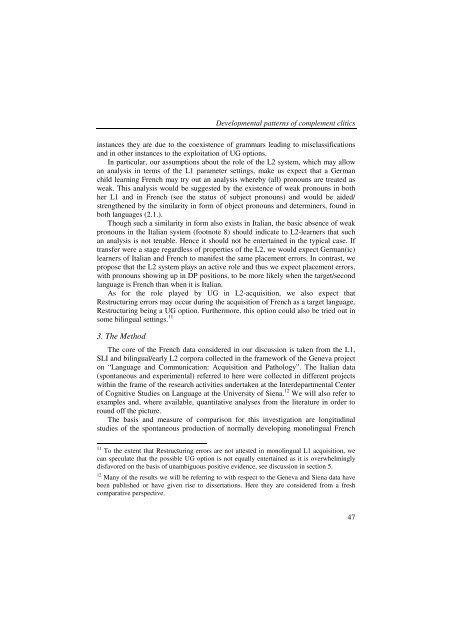Untitled - Lear
Untitled - Lear
Untitled - Lear
Create successful ePaper yourself
Turn your PDF publications into a flip-book with our unique Google optimized e-Paper software.
Developmental patterns of complement clitics<br />
instances they are due to the coexistence of grammars leading to misclassifications<br />
and in other instances to the exploitation of UG options.<br />
In particular, our assumptions about the role of the L2 system, which may allow<br />
an analysis in terms of the L1 parameter settings, make us expect that a German<br />
child learning French may try out an analysis whereby (all) pronouns are treated as<br />
weak. This analysis would be suggested by the existence of weak pronouns in both<br />
her L1 and in French (see the status of subject pronouns) and would be aided/<br />
strengthened by the similarity in form of object pronouns and determiners, found in<br />
both languages (2.1.).<br />
Though such a similarity in form also exists in Italian, the basic absence of weak<br />
pronouns in the Italian system (footnote 8) should indicate to L2-learners that such<br />
an analysis is not tenable. Hence it should not be entertained in the typical case. If<br />
transfer were a stage regardless of properties of the L2, we would expect German(ic)<br />
learners of Italian and French to manifest the same placement errors. In contrast, we<br />
propose that the L2 system plays an active role and thus we expect placement errors,<br />
with pronouns showing up in DP positions, to be more likely when the target/second<br />
language is French than when it is Italian.<br />
As for the role played by UG in L2-acquisition, we also expect that<br />
Restructuring errors may occur during the acquisition of French as a target language,<br />
Restructuring being a UG option. Furthermore, this option could also be tried out in<br />
some bilingual settings. 11<br />
3. The Method<br />
The core of the French data considered in our discussion is taken from the L1,<br />
SLI and bilingual/early L2 corpora collected in the framework of the Geneva project<br />
on “Language and Communication: Acquisition and Pathology”. The Italian data<br />
(spontaneous and experimental) referred to here were collected in different projects<br />
within the frame of the research activities undertaken at the Interdepartmental Center<br />
of Cognitive Studies on Language at the University of Siena. 12 We will also refer to<br />
examples and, where available, quantitative analyses from the literature in order to<br />
round off the picture.<br />
The basis and measure of comparison for this investigation are longitudinal<br />
studies of the spontaneous production of normally developing monolingual French<br />
11 To the extent that Restructuring errors are not attested in monolingual L1 acquisition, we<br />
can speculate that the possible UG option is not equally entertained as it is overwhelmingly<br />
disfavored on the basis of unambiguous positive evidence, see discussion in section 5.<br />
12 Many of the results we will be referring to with respect to the Geneva and Siena data have<br />
been published or have given rise to dissertations. Here they are considered from a fresh<br />
comparative perspective.<br />
47
















